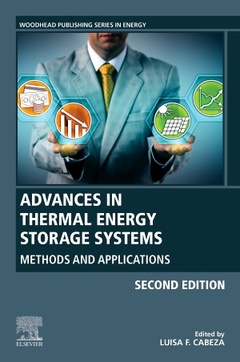Description
Advances in Thermal Energy Storage Systems (2nd Ed.)
Methods and Applications
Woodhead Publishing Series in Energy Series
Coordinator: Cabeza Luisa F.
Language: English
Subjects for Advances in Thermal Energy Storage Systems:
Keywords
Aggregated thermal demand; Applications; Building envelope; Buildings; CO2 mitigation potential; CSP; Carbonate and chloride; Cash flows; Characteristics of water; Chemical; Chemical energy storage; Cogeneration; Combined heat and power; Concrete storage; Continuum modeling; Control strategies; Cooling; Daily storages; Density function theory; Direct and indirect two-tank storage; District cooling; District heating; Domestic hot water; Domestic setting; Encapsulation technologies; Energy consumption; Energy savings; Energy storage; Energy storage systems; Enthalpy formulation; Equilibrium; Experimental characterization; Fossil fuels; Future trends; Heat and mass transfer; Heat content; Heat loss; Heat transfer; Hot water storage; Hot water tanks; Individual residential building; Inlet stratifier; Investment costs; Latent heat; Latent heat storage; Liquid metal and alloy heat transfer materials; Liquid sensible storage media; Low melting–point mixtures; Mampel’s approach; Mass transfer; Melting; Modeling; Molecular dynamics; Molten nitrate/nitrite solar salts; Numerical modeling; Overview; Particulate storage; Phase change material; Phase change materials (PCM); Phase change materials (PCMs); Regenerator storage; Reversible reaction; Seasonal storage; Seasonal storages; Sensible heat; Sensible heat storage; Shape-stabilized PCM; Simulation; Smart hot water tanks; Solid media; Solidification; Sorption; Sorption energy storage requirements; Sorption heat storage; Sorption systems; Space heating; Thermal and electrical energy; Thermal bridge; Thermal conductivity; Thermal energy; Thermal energy storage; Thermal energy storage (TES); Thermal stratification; Thermochemical; Thermochemical heat storage; Thermodynamics; Thermophysical; Trigeneration; Valorization; Viscosity; Waste heat recovery; Water pit heat storages; Working pairs
796 p. · 15x22.8 cm · Hardback
Description
/li>Contents
/li>Readership
/li>Biography
/li>Comment
/li>
Advances in Thermal Energy Storage Systems, 2nd edition, presents a fully updated comprehensive analysis of thermal energy storage systems (TES) including all major advances and developments since the first edition published. This very successful publication provides readers with all the information related to TES in one resource, along with a variety of applications across the energy/power and construction sectors, as well as, new to this edition, the transport industry. After an introduction to TES systems, editor Dr. Prof. Luisa Cabeza and her team of expert authors consider the source, design and operation of the use of water, molten salts, concrete, aquifers, boreholes and a variety of phase-change materials for TES systems, before analyzing and simulating underground TES systems.
This edition benefits from 5 new chapters covering the most advanced technologies including sorption systems, thermodynamic and dynamic modelling as well as applications to the transport industry and the environmental and economic aspects of TES. It will benefit researchers and academics of energy systems and thermal energy storage, construction engineering academics, engineers and practitioners in the energy and power industry, as well as architects of plants and storage systems and R&D managers.
1. Introduction to thermal energy storage (TES) systems
Part One: Sensible heat storage systems2. Using water for heat storage in thermal energy storage (TES) systems3. Using molten salts and other liquid sensible storage media in thermal energy storage (TES) systems4. Using concrete and other solid storage media in thermal energy storage (TES) systems5. The use of aquifers as thermal energy storage (TES) systems6. The use of borehole thermal energy storage (BTES) systems7. Analysis, modeling and simulation of underground thermal energy storage (UTES) systems
Part Two: Latent heat storage systems8. Using ice and snow in thermal energy storage systems9. Using solid-liquid phase change materials (PCMs) in thermal energy storage systems10. Microencapsulation of phase change materials (PCMs) for thermal energy storage systems11. Design of latent heat storage systems using phase change materials (PCMs)12. Modelling of heat transfer in phase change materials (PCMs) for thermal energy storage systems13. Integrating phase change materials (PCMs) in thermal energy storage systems for buildings
Part Three: Sorption and thermochemical heat storage systems14. Sorption systems for thermal energy storage15. Thermodynamic and dynamic models for thermal energy storage systems16. Using thermochemical reactions in thermal energy storage systems17. Modeling thermochemical reactions in thermal energy storage systems
Part Four: Systems operation and applications18. Monitoring and control of thermal energy storage systems19. Thermal energy storage systems for heating and hot water in residential buildings20. Thermal energy storage systems for district heating and cooling21. Thermal energy storage (TES) systems using heat from waste22. Thermal energy storage (TES) systems for cogeneration and trigeneration systems23. Thermal energy storage systems for concentrating solar power (CSP) technology24. Thermal energy storage (TES) systems for greenhouse technology25. Thermal energy storage (TES) systems for cooling in residential buildings26. Thermal energy storage in the transport sector27. Environmental aspects of thermal energy storage28. Economic aspects of thermal energy storage
- Includes 5 brand new chapters covering Sorption systems, Thermodynamic and dynamic models, applications to the transport sector, environmental aspects of TES and economic aspects of TES
- All existing chapters are updated and revised to reflect the most recent advances in the research and technologies of the field
- Reviews heat storage technologies, including the use of water, molten salts, concrete and boreholes in one comprehensive resource
- Describes latent heat storage systems and thermochemical heat storage
- Includes information on the monitoring and control of thermal energy storage systems, and considers their applications in residential buildings, power plants and industry
These books may interest you

Latent Heat-Based Thermal Energy Storage SystemsMaterials, Applications, and the Energy Market 161.46 €

Principles of Solar Engineering 209.19 €


